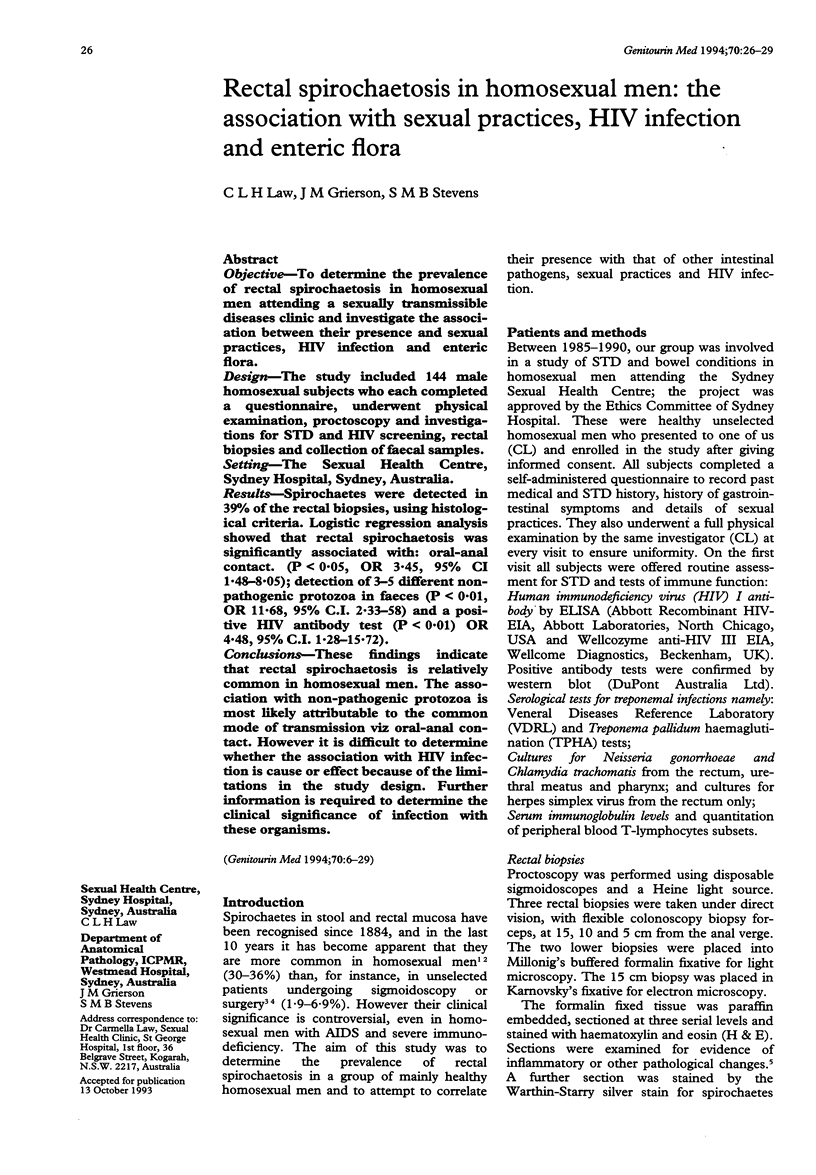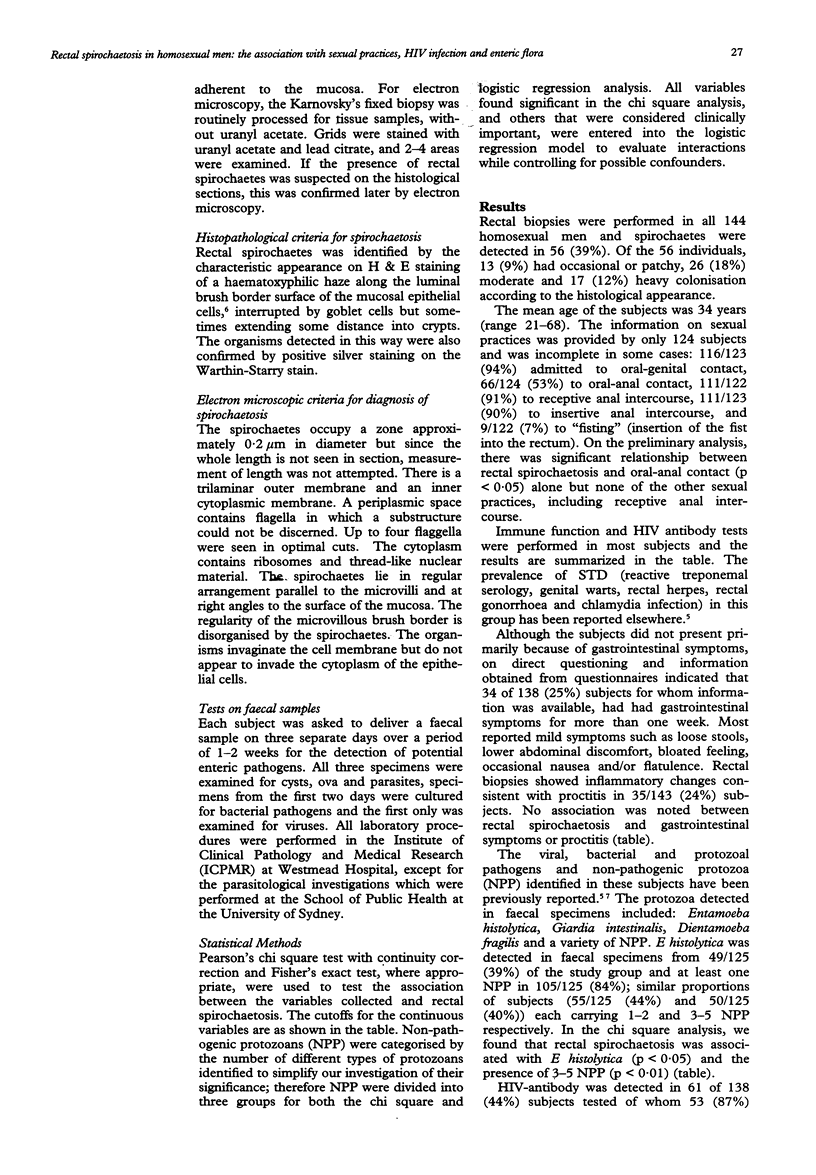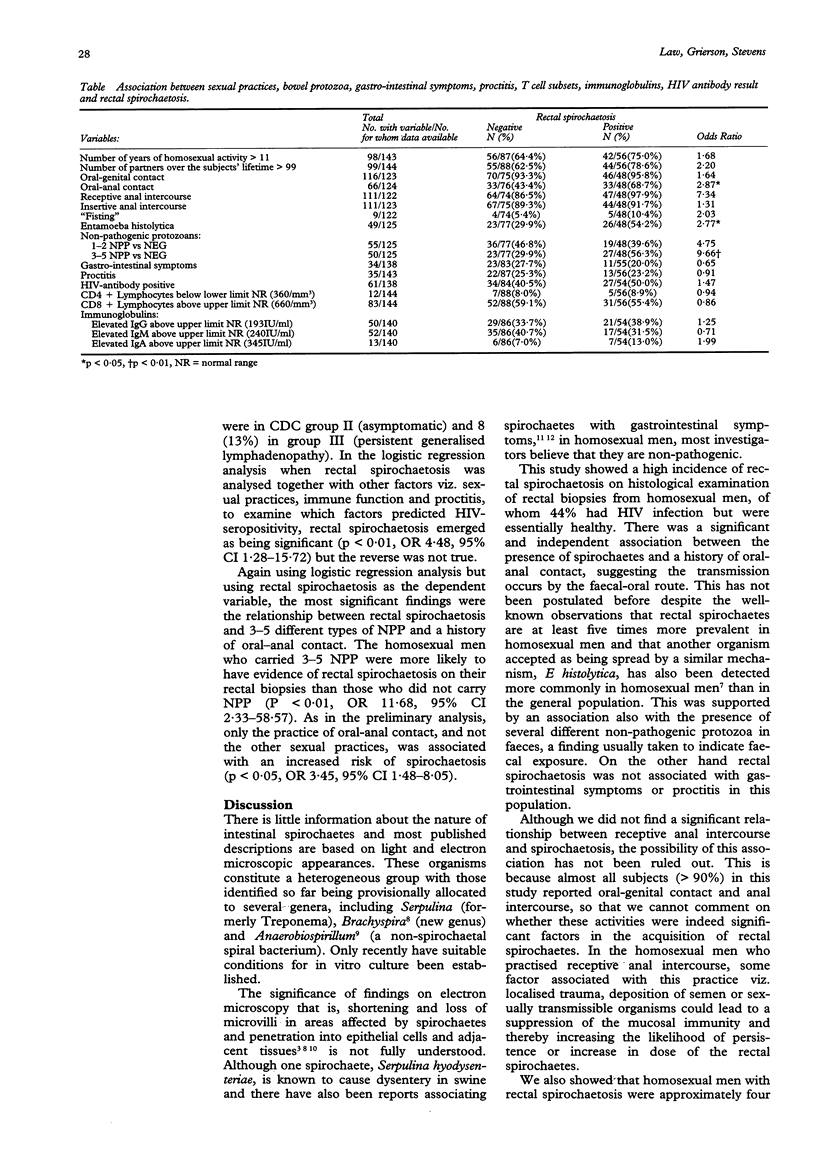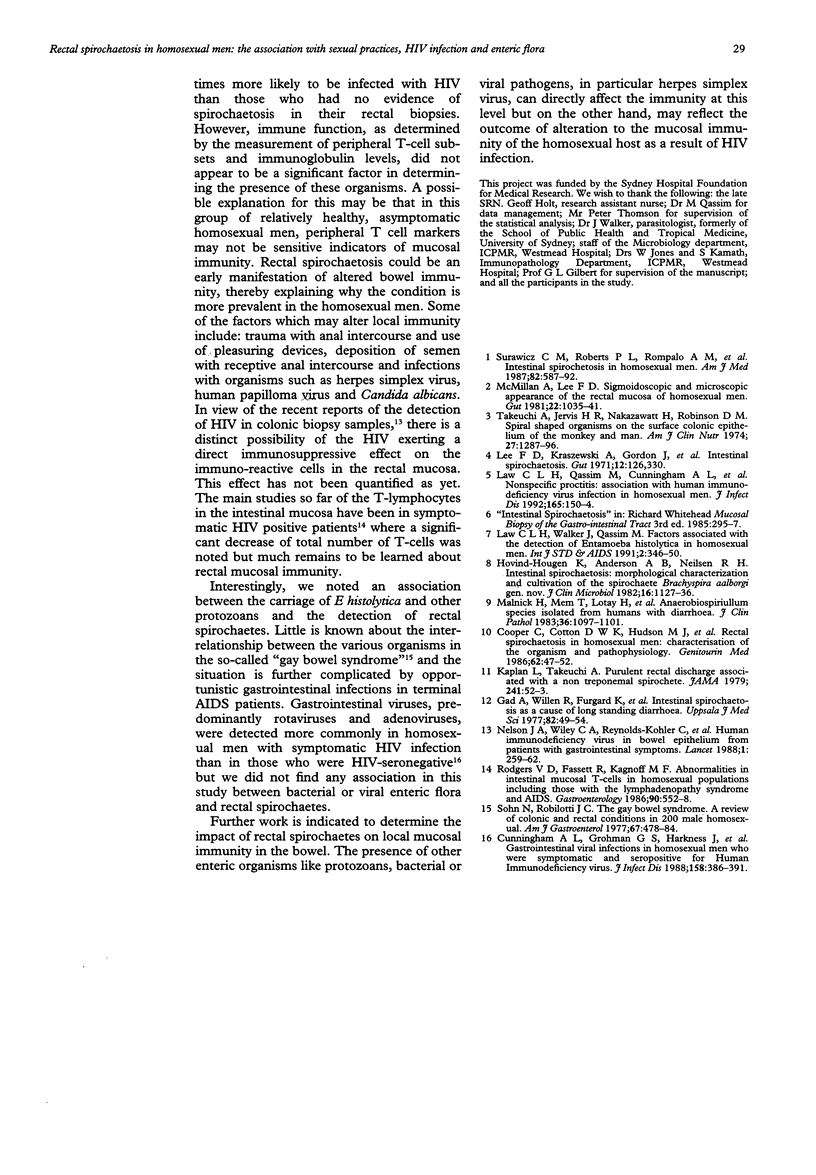Abstract
OBJECTIVE--To determine the prevalence of rectal spirochaetosis in homosexual men attending a sexually transmissible diseases clinic and investigate the association between their presence and sexual practices, HIV infection and enteric flora. DESIGN--The study included 144 male homosexual subjects who each completed a questionnaire, underwent physical examination, proctoscopy and investigations for STD and HIV screening, rectal biopsies and collection of faecal samples. SETTING--The Sexual Health Centre, Sydney Hospital, Sydney, Australia. RESULTS--Spirochaetes were detected in 39% of the rectal biopsies, using histological criteria. Logistic regression analysis showed that rectal spirochaetosis was significantly associated with: oral-anal contact. (P < 0.05, OR 3.45, 95% CI 1.48-8.05); detection of 3-5 different non-pathogenic protozoa in faeces (P < 0.01, OR 11.68, 95% C.I. 2.33-58) and a positive HIV antibody test (P < 0.01) OR 4.48, 95% C.I. 1.28-15.72). CONCLUSIONS--These findings indicate that rectal spirochaetosis is relatively common in homosexual men. The association with non-pathogenic protozoa is most likely attributable to the common mode of transmission viz oral-anal contact. However it is difficult to determine whether the association with HIV infection is cause or effect because of the limitations in the study design. Further information is required to determine the clinical significance of infection with these organisms.
Full text
PDF



Selected References
These references are in PubMed. This may not be the complete list of references from this article.
- Cooper C., Cotton D. W., Hudson M. J., Kirkham N., Wilmott F. E. Rectal spirochaetosis in homosexual men: characterisation of the organism and pathophysiology. Genitourin Med. 1986 Feb;62(1):47–52. doi: 10.1136/sti.62.1.47. [DOI] [PMC free article] [PubMed] [Google Scholar]
- Cunningham A. L., Grohman G. S., Harkness J., Law C., Marriott D., Tindall B., Cooper D. A. Gastrointestinal viral infections in homosexual men who were symptomatic and seropositive for human immunodeficiency virus. J Infect Dis. 1988 Aug;158(2):386–391. doi: 10.1093/infdis/158.2.386. [DOI] [PMC free article] [PubMed] [Google Scholar]
- Hovind-Hougen K., Birch-Andersen A., Henrik-Nielsen R., Orholm M., Pedersen J. O., Teglbjaerg P. S., Thaysen E. H. Intestinal spirochetosis: morphological characterization and cultivation of the spirochete Brachyspira aalborgi gen. nov., sp. nov. J Clin Microbiol. 1982 Dec;16(6):1127–1136. doi: 10.1128/jcm.16.6.1127-1136.1982. [DOI] [PMC free article] [PubMed] [Google Scholar]
- Law C. L., Qassim M., Cunningham A. L., Mulhall B., Grierson J. M. Nonspecific proctitis: association with human immunodeficiency virus infection in homosexual men. J Infect Dis. 1992 Jan;165(1):150–154. doi: 10.1093/infdis/165.1.150. [DOI] [PMC free article] [PubMed] [Google Scholar]
- Law C. L., Walker J., Qassim M. H. Factors associated with the detection of Entamoeba histolytica in homosexual men. Int J STD AIDS. 1991 Sep-Oct;2(5):346–350. doi: 10.1177/095646249100200507. [DOI] [PubMed] [Google Scholar]
- Lee F. D., Kraszewski A., Gordon J., Howie J. G., McSeveney D., Harland W. A. Intestinal spirochaetosis. Gut. 1971 Feb;12(2):126–133. doi: 10.1136/gut.12.2.126. [DOI] [PMC free article] [PubMed] [Google Scholar]
- Malnick H., Thomas M. E., Lotay H., Robbins M. Anaerobiospirillum species isolated from humans with diarrhoea. J Clin Pathol. 1983 Oct;36(10):1097–1101. doi: 10.1136/jcp.36.10.1097. [DOI] [PMC free article] [PubMed] [Google Scholar]
- McMillan A., Lee F. D. Sigmoidoscopic and microscopic appearance of the rectal mucosa in homosexual men. Gut. 1981 Dec;22(12):1035–1041. doi: 10.1136/gut.22.12.1035. [DOI] [PMC free article] [PubMed] [Google Scholar]
- Nelson J. A., Wiley C. A., Reynolds-Kohler C., Reese C. E., Margaretten W., Levy J. A. Human immunodeficiency virus detected in bowel epithelium from patients with gastrointestinal symptoms. Lancet. 1988 Feb 6;1(8580):259–262. doi: 10.1016/s0140-6736(88)90348-0. [DOI] [PubMed] [Google Scholar]
- Rodgers V. D., Fassett R., Kagnoff M. F. Abnormalities in intestinal mucosal T cells in homosexual populations including those with the lymphadenopathy syndrome and acquired immunodeficiency syndrome. Gastroenterology. 1986 Mar;90(3):552–558. doi: 10.1016/0016-5085(86)91108-x. [DOI] [PubMed] [Google Scholar]
- Sohn N., Robilotti J. G., Jr The gay bowel syndrome. A review of colonic and rectal conditions in 200 male homosexuals. Am J Gastroenterol. 1977 May;67(5):478–484. [PubMed] [Google Scholar]
- Surawicz C. M., Roberts P. L., Rompalo A., Quinn T. C., Holmes K. K., Stamm W. E. Intestinal spirochetosis in homosexual men. Am J Med. 1987 Mar 23;82(3 Spec No):587–592. doi: 10.1016/0002-9343(87)90104-5. [DOI] [PubMed] [Google Scholar]
- Takeuchi A., Jervis H. R., Nakazawa H., Robinson D. M. Spiral-shaped organisms on the surface colonic epithelium of the monkey and man. Am J Clin Nutr. 1974 Nov;27(11):1287–1296. doi: 10.1093/ajcn/27.11.1287. [DOI] [PubMed] [Google Scholar]


